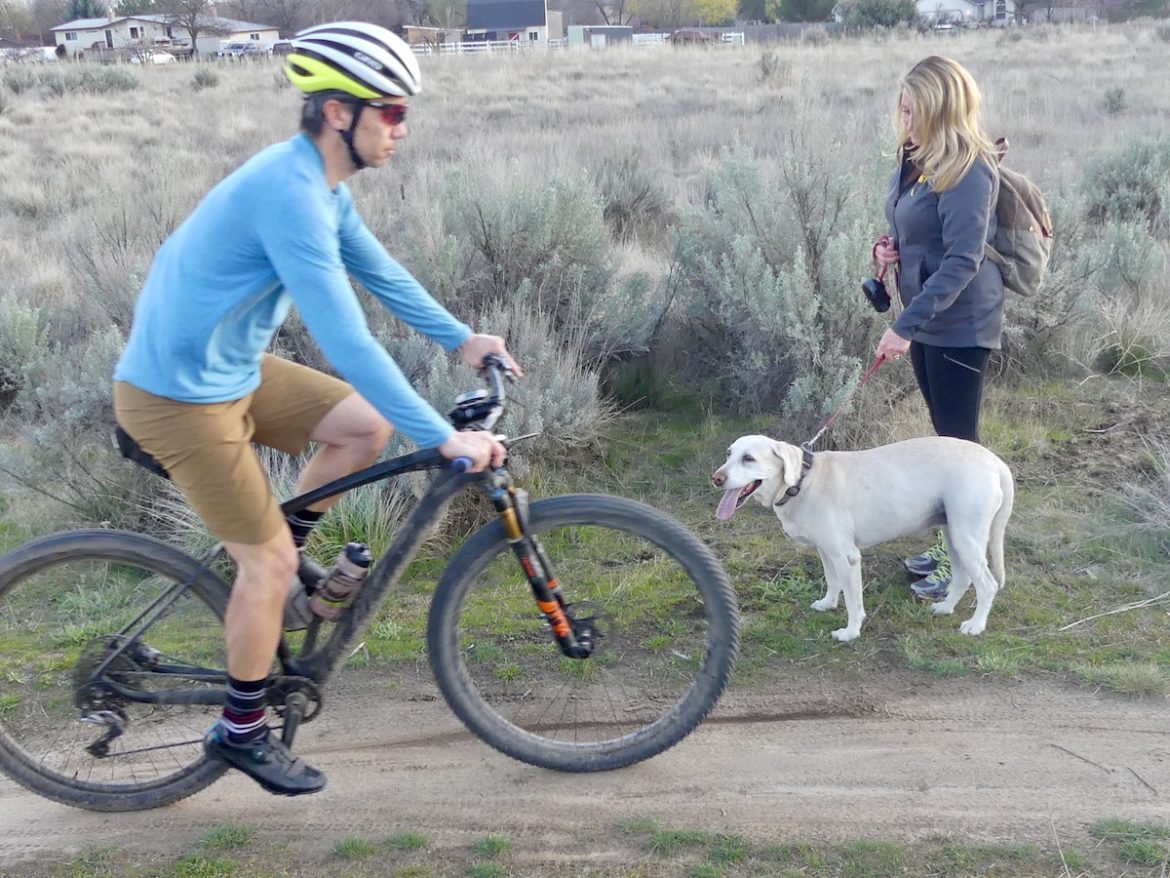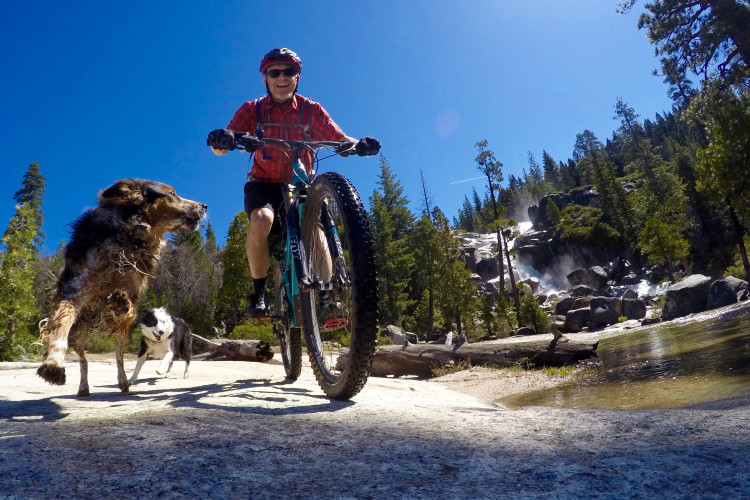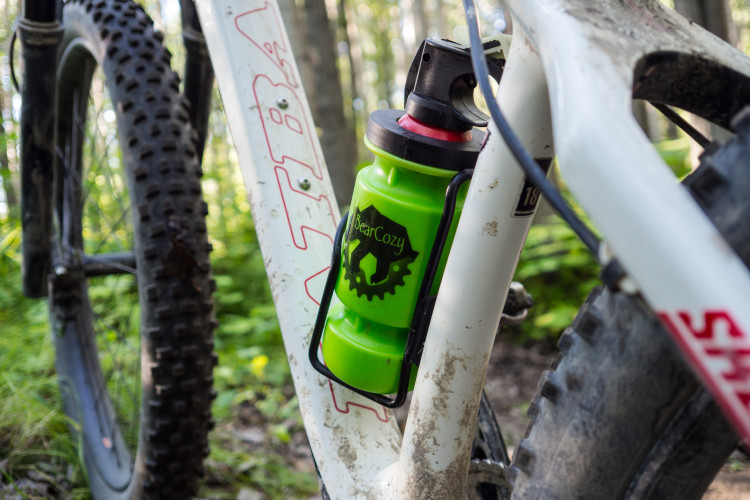Dogs may be man’s best friend, but the adage doesn’t necessarily apply to a man (or woman) on a mountain bike. Most mountain bike trails have hikers, and many hikers have dogs. There’s nothing wrong with that because it typically takes a community to maintain a trail system.

Hikers and dogs are part of the equation, but dogs can cause collisions, make riders swerve and crash, or a dog can bite a rider. Those situations are typically rare, and this isn’t intended to be a bash against our four-legged friends.
As a life-long dog owner, amateur dog trainer and mountain biker, I like dogs and understand their basic psychology, most of which mountain bikers know intuitively, or by experience. Understanding why a dog’s instincts might make it react a certain way can help you avoid a bad experience on the trail.
Here are 10 tips to help you avoid an unwanted dog encounter:

Don’t surprise the dog or its owner: Nobody likes to be surprised on the trail, dogs included, and a dog’s natural reaction may be to bite you. A surprised dog might also see you as a threat to its owner, which can trigger a protective reaction.
Do your best to let the owner know you’re coming in a loud, but friendly, voice well in advance of passing them. If the dog is off its leash, keep a watchful eye, and if the dog suddenly takes interest in you, be ready to react. If the dog is in the trail, don’t get too close without letting it know you’re there.

Give the owner time to get the dog under control: Even if the dog is on a leash, it may take a little time to get it off the trail and in a safe place for you to pass. Announcing yourself and then zipping past might not provide enough time, and the dog could lunge at you, or jump back into the trail and cause a collision. Dog owners usually appreciate it when you give them a chance to get their dog seated and settled. It may interrupt your ride, but remember, they’re trying to protect their dog and you.

Read the body language: This applies to the dog and the owner, but especially the dog. It’s usually safe to pass a calm dog, even at close distance. But sometimes it’s hard to tell if an excited dog is happy or potentially aggressive. Even a happy, friendly dog that darts in front of you, or jumps on you, can cause a crash.
If you see a dog that has a stiff body posture, hackled-up hair, is baring teeth, or growling, wait until the owner has it completely under control and the dog calms. If the owner acts pissed off at you, the dog may sense that and become aggressive. If there’s a near collision, regardless of who’s at fault, be calm and non-confrontational so things don’t escalate. Even it’s not your fault, it’s two against one, assuming you’re riding alone.
Know the dog breed: Dog breeds have certain traits and fall into certain categories, such has hunting breeds, herding breeds, and so on. It’s good to know the breed because some dogs are more likely to be aggressive.
For example, herding breeds, such as shepherds, heelers, and border collies are bred to herd animals, and a mountain biker could trigger that herding instinct. One way a herding dog controls a larger animal is by nipping at its legs, which is bad for mountain bikers. Guard dogs like dobermans, rottweilers, and pit bulls can be aggressive if they feel their owner is threatened. Quickly and silently approaching on a bike could trigger that protective instinct. Even small dogs, such as terriers, are descendants of hunting breeds and can be aggressive.
That doesn’t mean all dog breeds fit into neat categories, or that some breeds are always safe and others dangerous. Each dog also has a unique personality and different levels of training, but if you encounter a herding breed, or a guard dog, you should be more cautious than if you encounter a gentle, friendly breed.
Talk to the dog: This might sound strange, but if you approach an off-leash dog, try to get its attention and talk in a soothing, friendly tone. Watch its reaction to your voice. You may be surprised how quickly its body language changes when it hears a friendly voice. If it’s ignoring you, you’re probably safe to pass because the dog is interested in something else.
Don’t try to outrun a dog unless you know you can win: Dogs are fast, agile and not limited to the trail. And if you’re both going fast and a dog catches up with you, it’s probably not going to end well for either. Remember dogs descended from predators, so they have a natural instinct to chase. Again, even if they’re not being aggressive, they can cause a crash, which could be worse than a nip on the leg.
Even a leashed dog can be hazardous, so expect the unexpected: Dogs can be quick, and most are strong for their size. If a dog lunges, it can pull the owner forward a few feet, and the leash can slip from a person’s grasp. Give yourself a buffer and be ready to react.

Don’t try to touch a dog you don’t know: This is probably common sense, but at the same time, I often have to stop myself from reaching out to pet a friendly dog with its head out a car window, or in the back of a truck. Even if a dog looks and acts friendly, you’re a stranger invading its space, and they don’t know your intentions. If you reach out and get bit, that one’s on you.
If things go south, be the alpha: If you have a face off with an aggressive dog, yell, “No! Bad dog!” Every dog knows what that means. Stand erect, make yourself appear big and put the bike between you and the dog to protect yourself. Use it as a weapon if you have to. Dogs are more likely to bluff than attack, but you never know. If they attack, which is unlikely, be aggressive and fight back.
Hold dog owners accountable: This is tricky because no one likes to be scolded or lectured on the trail. But you should let them know their dog caused a problem. Maybe a casual, “Hey, just want you to know your dog almost caused me to crash. Please keep it under control.” Never hurts to let them know you’re a dog owner, too, if that’s the case. Obviously, this depends on the severity of the situation, but shouting matches rarely fix problems.
If a dog bites you, or collides with you and causes a crash, don’t let the owner off the hook with a “sorry,” or it probably won’t change the dog’s or the owner’s behaviors. Dog owners are legally responsible for bites and other injuries caused by their animal. If they don’t take responsibility, or try to evade you, take a cell phone picture and get a license plate number when you get to the trailhead, then report them.
Your turn: Have you had any good or bad encounters with dogs on the trail?




















0 Comments